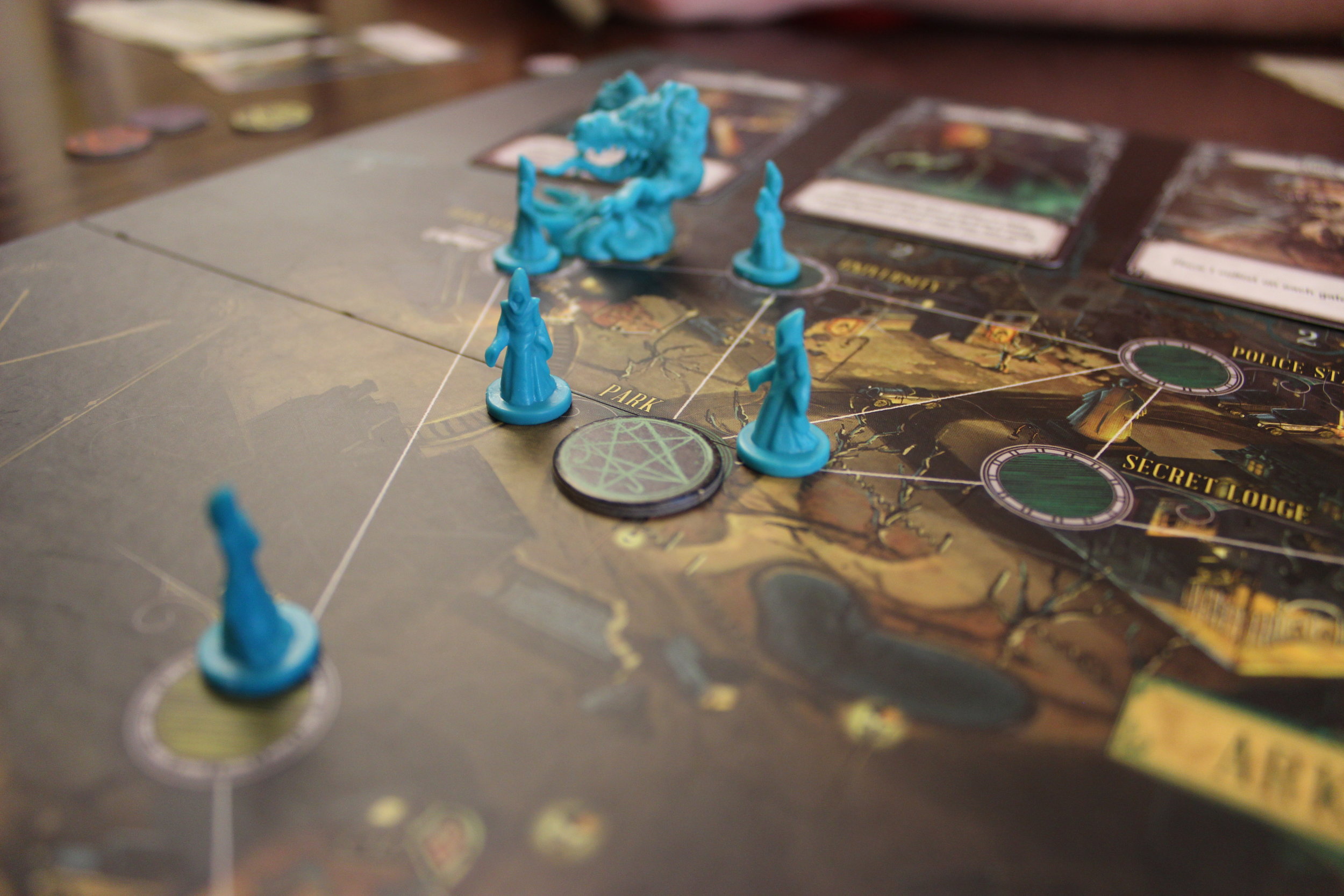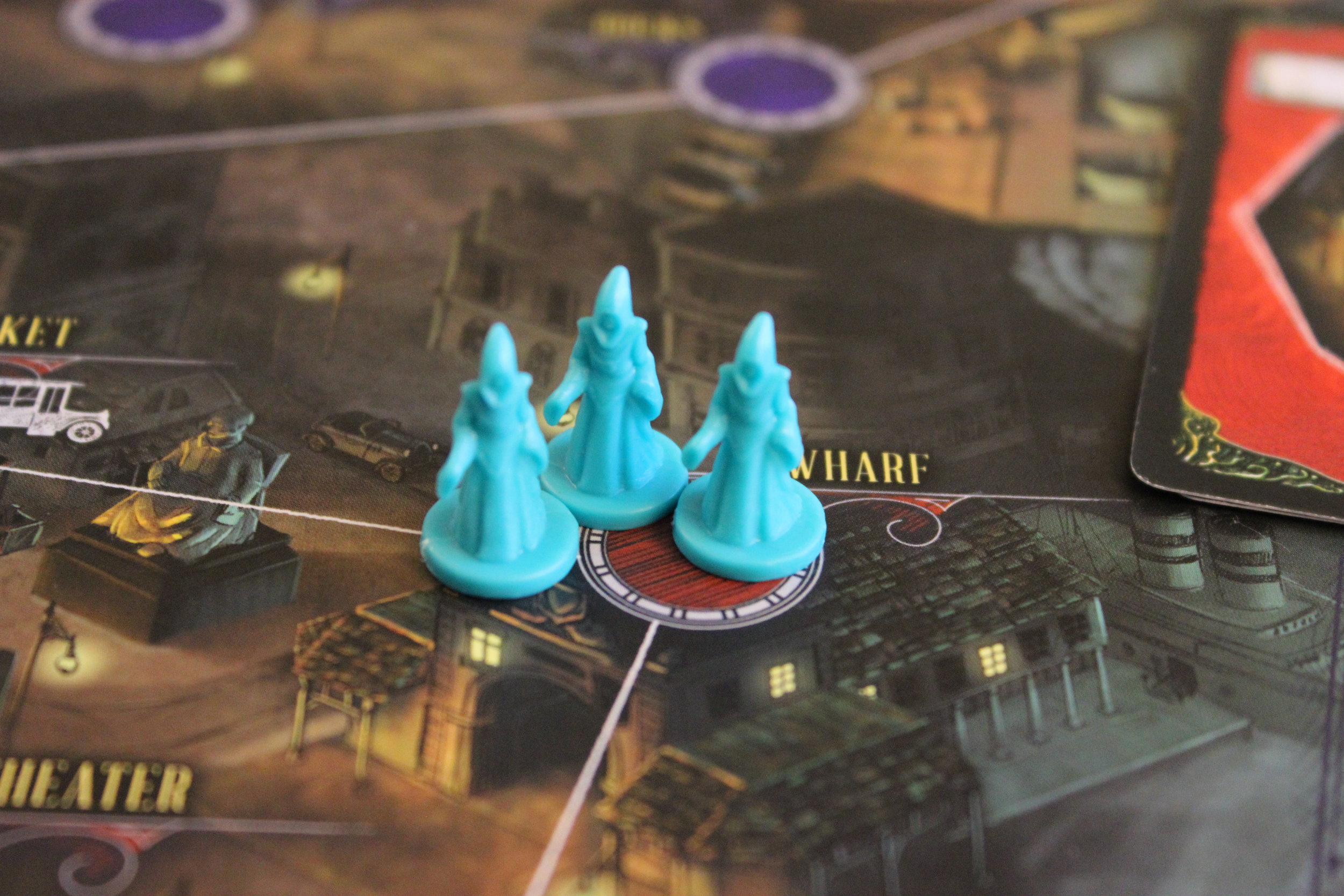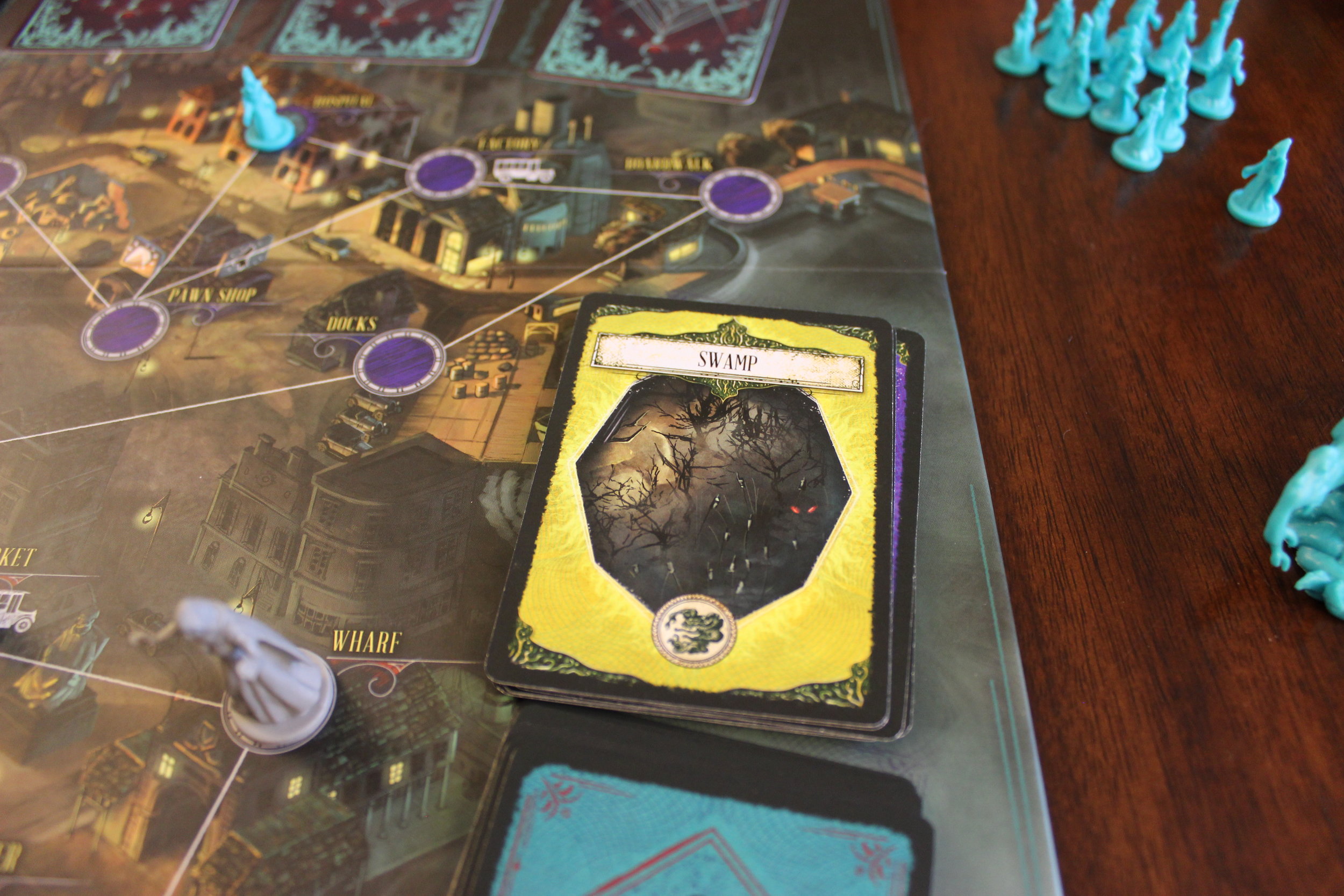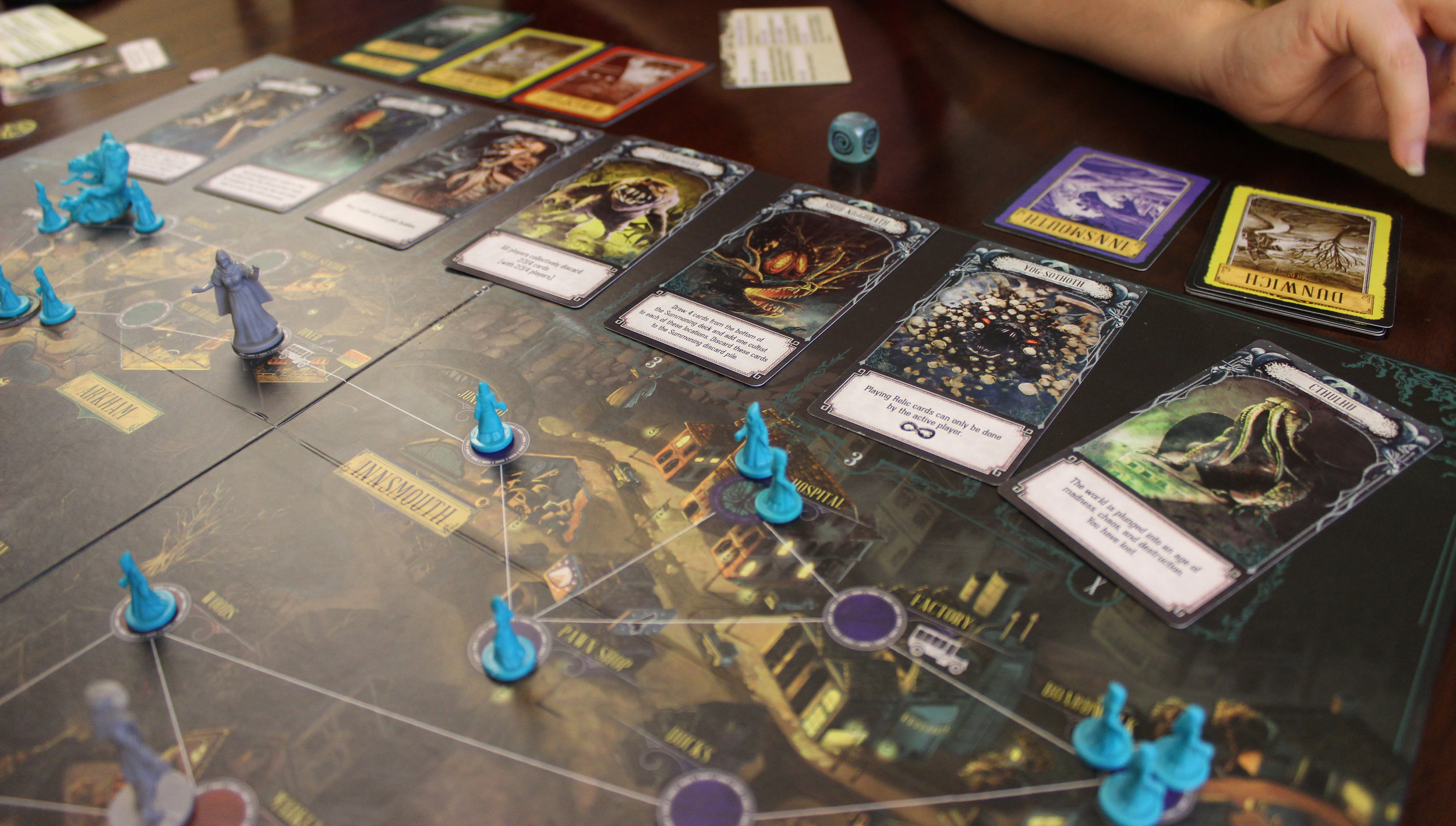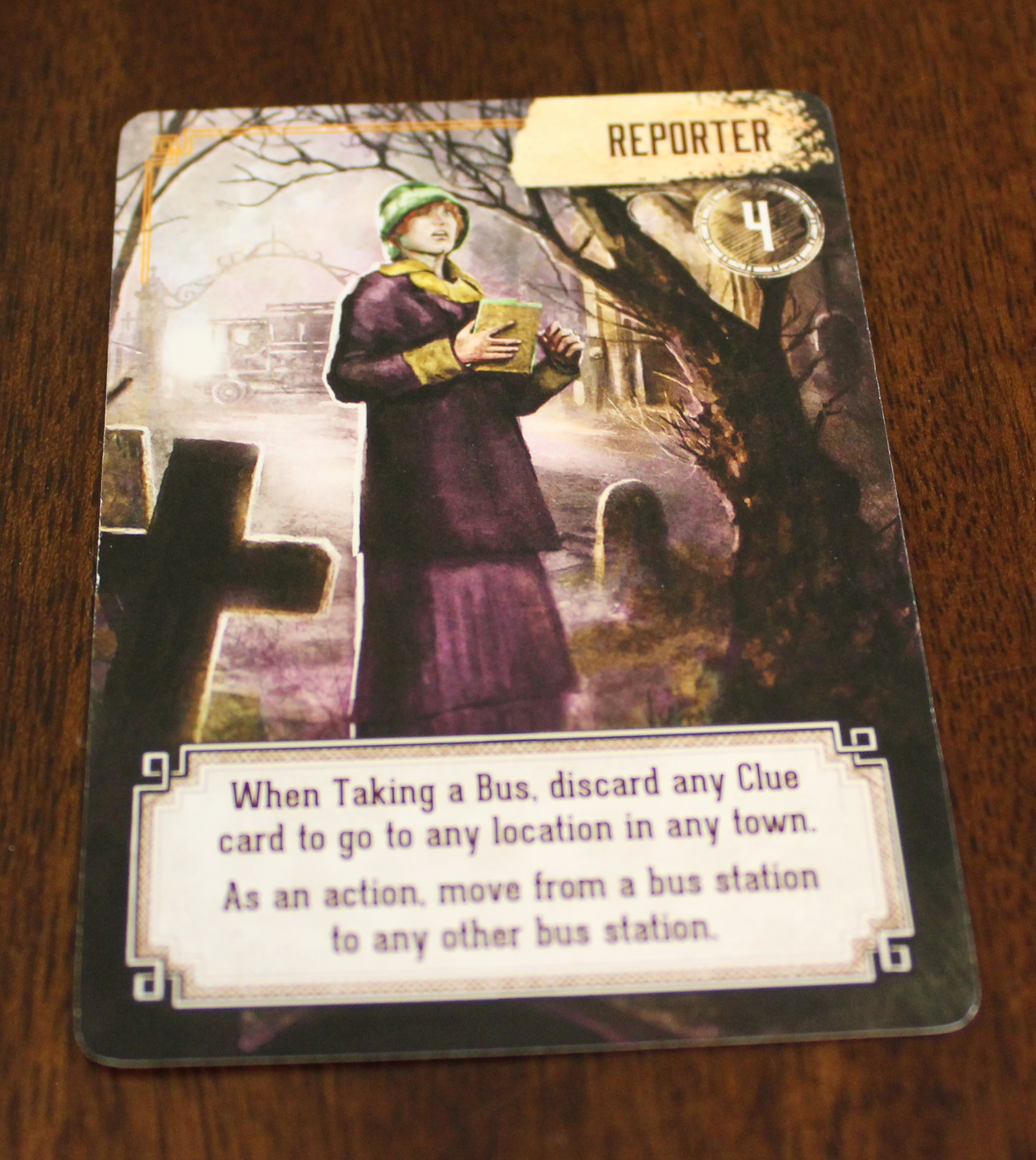Pandemic: Reign of Cthulhu
Pandemic: Reign of Cthulhu (2016) (BGG Link) - Action points, cooperative, hand management, set collection
Designers: Matt Leacock, Chuck D. Yager
Artists: Fred Jordan, Atha Kanaani, Paul Kluka, Chris Quilliams
Publisher: Z-Man Games
Number of Players: 2-4
Playing time: 45 min.
MSRP: $50
A great Evil slumbers under the very soil you tread my friend. It hides behind the darkness that fills the midnight void in the sky. It whispers dreams of madness and chaos to the masses from beneath deep waters. But the clues to halting its entrance into the world are all around you. A great Evil stirs somewhere in the dark recesses of the world. Can you stop it from waking up in time?
When Pandemic hit the scene in 2008, it gave players something they hadn't really seen before: a cooperative game ("We're playing together?") with the unusual theme of curing diseases. To this day, Pandemic is one of the most highly regarded modern board games, often appearing on "best games" lists. As of this article, it currently has three expansions, a fantastic dice version (also with an expansion), a competitive version where you play as the diseases, a version that takes place on the Iberian peninsula in 1848, and of course Pandemic Legacy: Season 1, with Season 2 already being playtested (alongside spoiled box art). Pandemic Legacy has been sitting on top of Board Game Geek's overall ranking since shortly after its release. Both Jeff and I have previously suggested Pandemic as an ideal gateway game for new players, and Pandemic Legacy found itself on several of our lists for best board game played in 2016.
Tabletop gaming is inundated with certain themes. If you like games about Medieval fantasy, space, trading in the Mediterranean, or zombies, then you really have your pick of the litter. This phenomena is not unknown to board gamers, and Pandemic is one of the titles to subvert this trend. Which is why it may seem odd that it has finally fallen to one of the most overused themes in board gaming: the Cthulhu mythos.
Understand that I'm not complaining about this, not exactly. It's just that if you're looking for a Cthulhu-based game, you can find one in almost every genre of board game. Want a Cthulhu Risk? There's Cthulhu Wars. Want a Cthulhu Scrabble? There's Unspeakable Words. How about Cthulhu Yahtzee? There's Elder Sign, and an actual honest-to-god Cthulhu Yahtzee. Arkham Horror, Eldritch Horror, Arkham Horror: The Card Game, Mansions of Madness, and Smash Up: The Obligatory Cthulhu Set (actual title) make up jut some of the more popular games containing everyone's favorite star spawn. So was this title really necessary? Let's take a look at Chuck D. Yager's Lovecraftian vision for Matt Leacock's critically acclaimed game and find out.
Game setup for four players.
Gameplay
In Reign of Cthulhu, two to four players must work together to close four gates spread across a map before the game sets off any of the myriad losing conditions. The map is made up of four fictional New England towns that were central to some of H.P. Lovecraft's most popular stories: Arkham, Dunwich, Innsmouth, and Kingsport. To close a gate, players must discard 5 location cards in that space's gate. Close all four gates, and the players have stopped Cthulhu's rise and win the game!
Evil Stirs acts as the "epidemic" card.
The game mechanics for turns work similarly to Pandemic. Each player uses their actions, draws two cards from the player deck, then reveals cards from the location deck to place cultists (this game's version of diseases). Like Pandemic, the player deck has "epidemic" cards spread throughout that trigger events, but here they're called "Evil Stirs."
These handy player aids let remind you what you can do on your turn.
Like the original Pandemic, players have four actions apiece. Each action can be used to move one space, discard a card on a bus stop to move to a space somewhere else on the board, trade cards with other players on their space, close a gate, or defeat cultists. Unlike the original Pandemic, adding a fourth cultist doesn't create an outbreak or chain reaction scenario. Rather, it reveals the next Old One.
Old Ones
While moving around the map, collecting clue cards and relics, and beating back waves of cultists will make up the majority of the game, players have to contend with the seven Old Ones lingering above the board. Each time there's an "outbreak" (here called an "Awakening Ritual") or an "Evil Stirs" card is revealed, the next Old One is flipped over. Some Old Ones have an effect that occurs immediately: discard cards, add extra cultists, etc. But some have permanent effects that will persist until the end of the game. As more Old Ones are revealed, the amount of location cards revealed at the end of each turn increases as wekk, so more cultists are added (just like the infection rate in Pandemic). The final Old One is always Cthulhu himself, with the wonderfully apt text: "The world is plunged into an age of madness, chaos, and destruction. You have lost."
Shoggoths
Besides cultists and Old Ones, players are also contending against Shoggoths, the horrific monsters made famous in Lovecraft's "At the Mountains of Madness." Shoggoths shamble about the board as location cards are drawn, always heading towards the nearest gate location. If they successfully get through a gate, they automatically trigger another Old One, bringing the players one step closer to losing the game. Unlike cultists, they take three actions to remove instead of just one. However, entering a space with a Shoggoth requires a roll of the sanity die...
Sanity
This would not be a Lovecraft/Cthulhu game without insanity. Each player starts with four sanity counters, but every time they draw an Evil Stirs card, enter a location with a Shoggoth, use a relic card, or use a gate location to move to another gate, they must roll the sanity die. There's a 1/3 chance nothing will happen and a 1/3 chance they'll lose a sanity, but they could also lose two sanity or summon two cultists to their location, possibly triggering another Awakening Ritual and bringing forth another Old One. If a player loses all of their sanity, they become insane (duh): they flip their character cards over, lose one action, and have slightly altered abilities. The only way for them to regain their sanity is to close a gate.
In some cases, insanity doesn't adversely affect the players as much as it could. But losing an entire action is detrimental to play, and if all players become insane, then it's a game loss.
Investigators
Just like the original Pandemic, each player has a different role that gives them special benefits:
Our heroes, ladies and gentleman. The guy in the top hat is an honest-to-god magician. Like, with a rabbit in his hat and everything. We're doomed.
- The Detective only needs four cards to seal a gate (like the Pandemic Scientist).
- The Doctor has 5 actions instead of 4 per turn (like the Pandemic Generalist).
- The Driver can move two spaces instead of one every time he uses the walk action.
- The Hunter can remove all cultists from a location with one action (like the Pandemic Medic), or defeat one Shoggoth a turn using one action instead of the three it normally requires.
- The Magician can have an extra card in his hand (like the Pandemic Archivist), starts with an extra relic card, and can trade relics with other players for free.
- The Occultist can use an action to move a cultist one space, or two actions to move a Shoggoth one space.
- The Reporter can move between bus stations without discarding a card, and can discard any card at a bus station to go anywhere on the board.
Relics
Relics replace events from the original Pandemic, but here they're absolutely necessary. A separate pile is kept next to the board, and a new relic is drawn every time a player kills a Shoggoth. These can be played at any time during the game as a free action, but playing them requires the roll of the sanity die.
Theme and Quality
Reign of Cthulhu drips with theme, like the slimy excretions of some pan-dimensional creeping horror. You know, Lovecraft and all that. Everything from the investigators, to the locations, to the card artwork screams Cthulhu mythos. It shares much of its atheistic and inspiration from other games like the Call of Cthulhu RPG and Fantasy Flight's Cthulhu games like Eldritch Horror and Elder Sign. You have a 1920-30's detective and a doctor, sure, but also an occult specialist and a magician. Even the rulebook opens with two pages of narrative to get you into the setting. The relic cards that pop up throughout the game help give the sense that you're actually plumbing the depths of forbidden knowledge in order to gain the slightest advantage over the unstoppable forces of the cosmos.
That being said, the theme here only works as much as you want it to. It's not as immersive as other Cthulhu games with more story-driven narratives, like the Arkham/Eldritch Horror games or Mansions of Madness. I found myself playing it with people generally unfamiliar with Lovecraftian lore, so they didn't get as excited to see an appearance of a Mi-Go Eye or understand why you don't mention the King in Yellow's "H" name. That's not to say that they didn't enjoy Reign of Cthulhu, but it's like playing a Harry Potter game and shouting "Wingardium leviosa!" like a deranged person when no one around you knows what you're talking about. Why does everyone keep looking at me like I'm crazy? I'm not the crazy one here! I'll put the knife down when you start making sense!!!
...So while the game is rich and stylish in its use of theme, you're only going to get as much out of it as you put in yourself.
What helps are the fantastic plastic miniatures provided for the investigators, cultists, and Shoggoths. The original Pandemic really only needed colored pawns and small plastic cubes to represent the players and the diseases. But by providing the players with actual miniatures for their roles, and colorful cultists and Shoggoths that stand out on the board, the game really comes to life. The miniatures are great quality, and the box provides a space for each one for enthusiasts who enjoy painting them.
The cards and boards are also colorful and high-quality, although our board doesn't exactly sit flat (much like our Pandemic Legacy board; come on, Z-Man Games!). Each location has a small illustration of the building which is then superimposed on the location cards, and while the clue cards are the same for each location, they use a dreary illustration that compliments the horror narrative.
Final Thoughts
I played this game 6 times total: 5 times with four players, and one time with two players. There are two things that need to be noted: the first 5 games, we forgot an incredibly important rule: every time you kill a Shoggoth, you gain a relic card. This turns out to be a big deal, because this leads to the second thing that needs to be said: with the exception of the two-player game, we lost every single time.
One way to win, a million ways to lose.
One game we lost because we ran out of cultists. Another game we lost because Cthulhu was revealed. There are a lot of ways to lose. The closest we got as a team of four was closing 3 of the 4 gates, before finally succumbing to the evil. Most of the time we only closed one. The next day when I re-read the directions and realized we had forgotten the relic card rule, I kicked myself. But I also realized that having remembered that rule was no guarantee of victory.
This game is hard. And for Pandemic enthusiasts, it might not seem so at first glance. For one thing, unlike Pandemic, there are no specific locations on the player's cards, so you can trade any red card with a player on a shared red space. There's also only 24 locations, as opposed to Pandemic's 48, and only one type of opposition on the board (cultists) as opposed to four different diseases. Getting across the board is a lot simpler, too. By all accounts this game should be easier. But it's not.
Everything is stacked against you: The Old Ones make sweeping changes to the board state, the Shoggoths left unchecked can hasten the ending of the game, the cultist pile runs out very quickly, and every advantage the game gives you (using relics, moving between gates) is accompanied by the dreaded sanity roll, which could result in everything from "nothing" to "disaster." But this feeling of futility is necessary for a game to be true to the Lovecraft narrative. Lovecraft's stories were incredibly pessimistic about the human condition, and most protagonists met terrifying and grisly fates by delving too deeply into a world that man was not meant to know. Many Cthulhu games reflect that with increased difficulty and defeat as a common result.
There are some critiques I have that are more for Pandemic than this version specifically. Reign of Cthulhu has player roles that are often more useful than others. For example, I don't even want to imagine playing a game without the Hunter (much like the Medic in the original game). The "alpha gamer" problem (or quarterbacking as it's sometimes called) where one player can take over the game and direct everyone's actions is just as likely to occur here as the original game, but I've always seen that as more of an inter-personal problem between players rather than a design flaw.
The turn right before we would reveal Cthulhu and lose the game.
This leaves us with two final questions: "Did I like it?" and "Would I recommend it if you already have Pandemic?" I did like Reign of Cthulhu. I enjoyed the level of difficulty, and even though losing so much could be disheartening, I wanted to jump right back into it. Some of the other players had informed me the day after playing it that they wanted to try it again, so it's doing something right. I love the design and the pieces, and the game flows naturally once everyone becomes familiar with it. That's another thing: the game plays quickly, even with four players. It could take 30-60 minutes, but it rarely reached an hour. As a Cthulhu fan, the game sits well with me. But is it different enough to warrant an inclusion in your collection, especially if you already have Pandemic? Honestly, that's a personal preference. If you don't care at all about the theme, then I don't think it's that different and I probably wouldn't recommend it. However, if you like the Cthulhu mythos or can get behind the horror setting, and would appreciate a different take on a classic cooperative game, then I think this would do nicely alongside the original, or even replace it completely if you'd prefer. While the theme and the game isn't exactly innovative, it's still a nice take on a classic.
Edit 3/31/17: We've uploaded a playthrough video!
Geekundspiel Rating: Great! (Lose one point if you don't like the theme.)




